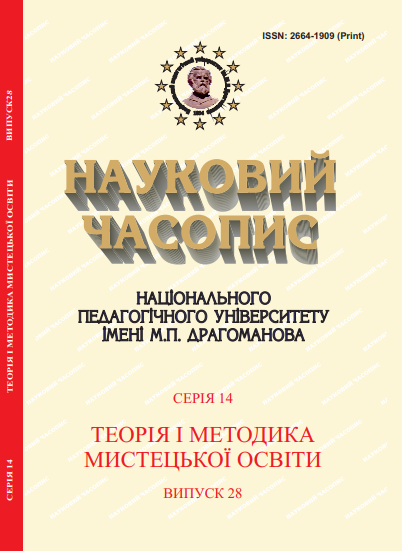Specifics of training teachers of musical art and choreography for genre and style analysis
DOI:
https://doi.org/10.31392/NPU-nc.series14.2022.28.10Keywords:
genre and style analysis, future music teachersAbstract
The article reveals a theoretical and methodological approach to the issue of genre and style analysis. One of the key moments of the modern stage of society's development is the reform of the higher education system. This requires new approaches, forms and methods of learning. The professional training of a music teacher requires mastery of pedagogical and musical skills.
The expediency of forming the skills of genre and style analysis of students of musical and pedagogical institutions of higher education is determined by professional activity. The lesson of musical art involves introducing students to highly artistic musical samples. The teacher must have the skills to analyze a musical work. An important aspect of a teacher's professional erudition understands the peculiarities of the composer's authorial identification. In our opinion, it is expedient to consider means of expression in music through the prism of genre and style, which will contribute to creating a full-fledged idea for students about the work of the composer in general and about the musical work in particular.
Therefore, the problem of genre-style analysis of an artistic work is actualized in the process of professional training of future music teachers. Musicological approaches to issues of genre and style are highlighted, and their complex nature is shown. It is emphasized that the understanding of defined categories is extremely detrimental to the professional training of future music teachers. First of all, it is connected with their performing activities, namely with their authorial reading of musical compositions, which requires the definition of genre-stylistic guidelines and their understanding through the prism of expressive means. Secondly, with pedagogical activity, there is still the formation of analytical skills in students. It is emphasized that the purpose of the genre-style analysis is to understand the features of the genre and style to which the composer's work belongs, to determine the typical features of his work, and the means of expression of the work. A plan of genre-style analysis based on the example of Seventh Chamber Symphony by Ye. Stankovych is proposed.
References
Гейченко М. І, Дідич Г. С. (2011). Використання художньо-педагогічного аналізу в процесі сприймання програмних музичних творів. КДПУ ім. В. Винниченка. Вип. 99. С. 82-91.
Козаренко О. В. (2000), Феномен української національної музичної мови. Львів. 286 с.
Коханик І. М. (2002), Музичний твір: взаємодія стабільного і мобільного в аспекті стилю. Наук. вісник НМАУ ім. П. І. Чайковського. Вип. 20. С. 44-51.
Масол Л. М. (2006), Загальна мистецька освіта: теорія і практика: монографія. Київ, Вид. «Промінь», 2006. 432с.
Нівельт О. А., (2000) Проблема цілісного аналізу музичних творів. Музичне мистецтво і культура. Одеса, Астропринт. Вип. 2. С.90-96
Сюта Б. Є, Деякі аспекти аналізу сучасної музики. URL: http://dspace.nbuv.gov.ua/bitstream/handle/123456789/43587/13Syuta.pdf?sequence=1
Падалка Г.М. (2008), Педагогіка мистецтва (теорія і методика викладання мистецьких дисциплін). Київ: Освіта України. 274 с.
Побережна Г., Щериця Т., (2004), Загальна теорія музики: Підручник. Київ, Вища школа. 303с.
Сисоєва С.О. (1996), Підготовка вчителя до формування творчої особистості учня. Київ, Поліграфкнига. 406 с.
Тукова И. Г. (2004), О понятии «жанровый стиль. Науч. вестн. Нац. муз. акад. Украины имени П. И. Чайковского. Вип. 38. С. 27–33.
Шип С. В. (1998), Музична форма від звуку до стилю : навчальний посібник. Київ, Заповіт. 368 с.
Downloads
Published
Issue
Section
License
Copyright (c) 2022 Nauk. čas. Nac. pedagogìčnogo unìv. ìm. M.P. Dragomanova, Ser. 14, Teor. metod. mistec. osv. [Scientific journal NPDU. Series 14. Theory and methodology of arts education]

This work is licensed under a Creative Commons Attribution-NonCommercial-NoDerivatives 4.0 International License.

